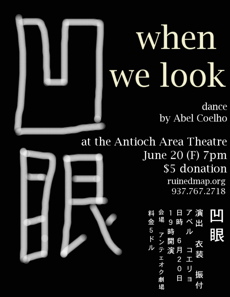
when we look 凹眼
at the Antioch Area Theatre
June 2008
Amanda Rosemary
Adam Rose
Jyunko Mizumochi
Abel Coelho
choreographed and designed by Abel Coelho
light board and sound board op Michael Casseli
Antioch Area Theatre Technical Director Adrian Davidson
gallery here
In psychology, visual perception is the ability to interpret information from visible light reaching the eyes.
The resulting perception is also known as eyesight, sight or vision. The various physiological components
involved in vision are referred to collectively as the visual system.
The major problem in visual perception is that what people see is not simply a translation of retinal stimuli
(i.e., the image on the retina). Thus people interested in perception have long struggled to explain what visual
processing does to create what we actually see.
There were two major Greek schools, providing a primitive explanation of how vision is carried out in the body.
The first was the "emission theory" which maintained that vision occurs when rays emanate from the eyes and
are intercepted by visual objects. If we saw an object directly it was by 'means of rays' coming out of the eyes
and again falling on the object. A refracted image was, however, seen by 'means of rays' as well, which came out
of the eyes, traversed through the air, and after refraction, fell on the visible object which was sighted as the result
of the movement of the rays from the eye. This theory was championed by scholars like Euclid and Ptolemy and their
followers.
The second school advocated the so called the 'intromission' approach which sees vision as coming from something
entering the eyes representative of the object. With its main propagators Aristotle, Galen and their followers, this theory
seems to have touched a little sense on what really vision is, but remained only a speculation lacking any experimental
foundation.
